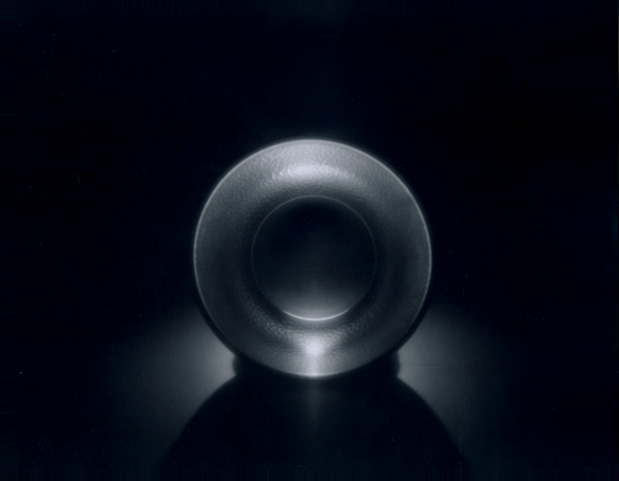Focus by eye
I tried focusing the Verito without a loupe, just moving the glass until it "looked right." It sorta works. There is less overall halo, but ultimately nothing is really defined.
Looking at the P&S manual that Jim posted, in particular the lovely head and shoulder portrait, it struct me that the texture of the print added a lot -- it has that gum look to it. So I scanned the 8x10 with a piece of ordinary letter paper between it and the light source to simulate the gum look. This is the result. This may come awfully close to the 'no digital' rule, but the effect is marvelous. (I'll delete it if requested of course).

America and Alfred Steiglitz

America & Alfred Steiglitz
Pretty wild for some tastes but I love the semi out of control light in this still life. Direct AM sun through an open window for this. 12" Semi Achromatic Pinkham & Smith at f11

Japan Basin
This is more sedate. Gertrude Kasebier would be proud.

japan basin f11
Tighter and at f11

tea things
These of course are all the multi personalities of a single lens, the 12" Pinkham & Smith Semi Achromatic f6. I think I'm done for the night. Good night all.
Pinkham Smith 1928 Catalog



















Contributed courtesy of Jim Galli, Tonopah, Nevada
Going for depth
I've had some free time on my hands, and decided to experiment with trying to get a 3D effect by using various lenses and shallow depth of focus. The best results came from a Wollensak Focus 5 (aka Vesta), next an Imagon, then a Ross. The Wolly and the Ross are petzval formula, and the Imagon is (... someone help me here). I got six good ones out of 15 shots, here are three of them.
----------------------
Ross lens, about 6 or 7 inch. Waterhouse stops. This was shot wide open (about f/3.8). I deliberately darkened it because I thought It looked good that way.

Imagon 250mm. This is using the smallest of the fuzz rings, which puts it about f/11. There is a definite 3D look to the result.

Wollensak Focus 5. This is a petzval formula lens ina studio shutter. This one gives (at least to me) the best illusion of depth.

Cheers,
George
Pinkham & Smith Ser III, Semi-Achromatic Doublet-'Contre Jour'
This image is 'Contre Jour', French for 'backlight', yeah, it sounded better to me in French. This is the last shot I've done with the SA and I think it reflects what this lens can do when the operator has gone a bit up the learning curve. These are called 'portrait' or 'soft focus' lenses but depending on the lighting scheme you can change the character/intensity of whatever softness the lens conveys to a particular subject matter.
I don't pretend to know every lighting scheme that will work w/this lens, I'm still scratching the surface w/F6, but in terms of me personally going forward w/this particular lens, I've gone forward w/the premise that frontal lighting results in halation everywhere. I've stayed away from frontal lighting, and used primarily three-quarter/sidelight/backlight and mostly but not all the time, at about a stop in illumination below the stop marked on the lens.
This lens flares out the light it sees, said another way, it does more w/less or at least that's the illusion. With illumination coming from the side or back things are more contrasty and with less illumination, less halation. You can control the halation(the intensity of the glow), and the character of the lens w/your illumination. Check out my 'Goggles' shot here, there's strong halation on either end of the goggles, I liked it, and felt it did something for the shot, now coming back to this shot, there's just a smattering of light, and the character of the glow is much more subtle.
I layed a Prototo 7" reflector on its side on a middle grey matt board on top of a stool so the front and back ends ended up sagging down, so I could line up the lens down low where the lens was. The matt board was sagging down and luckily for me it help force the perspective.
Illumination was by my strobes modeling ligh through a snoot which had a disc shaped grid inside to knock down the light and smooth it out so there was no harsh outline projected onto the matt board. I metered the light pattern left on either side of the reflector with globe of my meter half in light, half in shadow giving me a reading of F4. The lens was opened to F6 and the shutter time was roughly 4 seconds. This is what has worked for me on several of these shots, knocking down the illumination, and/or using it smaller areas which is what this amounts to w/side or backlight, and increasing the shutter time.
The Pinkham Smiths have a feel to the glow that cannot be fully described.
OMT, there was no frontal illumination used on this shot, all the light came from the snoot which above and behind the reflector, I adjusted the snoots light so that it came through the center hole of the reflector resulting in the photons you see bouncing around the dappled(or whatever you call it) reflector surfaces. It was interesting how the reflector took light exclusively from behind and bounced it around in the patterns you see.
Actually two more things, this lens focuses from the back forward, my focus point was the crescent shaped highlight at rear bottom central hole in the reflector, and the combination of eyeball focus and chemical focus carried forward to the front. With of my other lenses particularly when doing a portrait, I'll select a point knowing the focus will carry mostly backwards, not so w/this lens.
I've still got a lot to learn, but I think I'm getting a handle on the focus.
Take care

![[Your Site Name] [Your Site Name]](/storage/WideOpen%203%20tst2.jpg)
